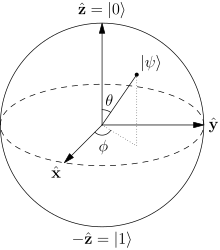Bernstein–Vazirani algorithm
The Bernstein–Vazirani algorithm, which solves the Bernstein–Vazirani problem is a quantum algorithm invented by Ethan Bernstein and Umesh Vazirani in 1992.[1] It's a restricted version of the Deutsch–Jozsa algorithm where instead of distinguishing between two different classes of functions, it tries to learn a string encoded in a function.[2] The Bernstein–Vazirani algorithm was designed to prove an oracle separation between complexity classes BQP and BPP.[1]

Problem statement
Given an oracle that implements some function , It is promised that the function is a dot product between and a secret string modulo 2. , find .
Algorithm
Classically, the most efficient method to find the secret string is by evaluating the function times where , [2]
In contrast to the classical solution which needs at least queries of the function to find , only one query is needed using quantum computing. The quantum algorithm is as follows: [2]
Apply a Hadamard transform to the qubit state to get
Perform a controlled negation of every state in the superposition generated by the previous Hadamard transformation for which the oracle when applied to this state returns 1. This transforms the superposition into
Another Hadamard transform is applied to each qubit which makes it so that for qubits where , its state is converted from to and for qubits where , its state is converted from to .
To obtain , a measurement on the Standard basis () is performed on the qubits. Graphically algorithm may be represented by the following diagram:

Where is the Hadamard transform.
See also
- Hidden Linear Function problem
References
- Ethan Bernstein and Umesh Vazirani (1997). "Quantum Complexity Theory". SIAM Journal on Computing. 26 (5): 1411–1473. doi:10.1137/S0097539796300921.
- S D Fallek, C D Herold, B J McMahon, K M Maller, K R Brown, and J M Amini (2016). "Transport implementation of the Bernstein–Vazirani algorithm with ion qubits". New Journal of Physics. 18. doi:10.1088/1367-2630/aab341.CS1 maint: multiple names: authors list (link)
